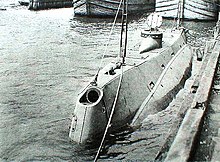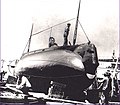USS Holland (SS-1): Difference between revisions
→References: Mentioned The Nautilus Memorial Submarine Library and Museum to the Klaxon article on Arthur Busch/Du Busc. |
|||
| Line 112: | Line 112: | ||
'''* The Submarine Pioneers,''' by CDR Richard Compton-Hall MBE RN. Published by Sutton Publishing LTD. UK 1999. |
'''* The Submarine Pioneers,''' by CDR Richard Compton-Hall MBE RN. Published by Sutton Publishing LTD. UK 1999. |
||
'''* The Klaxon,''' The U.S. Navy's official submarine force newsletter, April, 1992. Published by The Nautilus Memorial Submarine Force Library and Museum, New London/Groton CT. Article is about Arthur Busch/Du Busc and his key role in building America's (and Japan's) first submarines, circa 1896-1905. |
'''* The Klaxon,''' The U.S. Navy's official submarine force newsletter, April, 1992... top of page one. Published by The Nautilus Memorial Submarine Force Library and Museum, New London/Groton CT. Article is about Arthur Busch/Du Busc and his key role in building America's (and Japan's) first submarines, circa 1896-1905. |
||
'''* The New York Times''', obituary section, Sunday, [[March 11]], [[1956]]. Heading reads: "Arthur L. Du Busc, Submarine Pioneer, dies (at 90); Builder of First Craft Accepted by the United States". |
'''* The New York Times''', obituary section, Sunday, [[March 11]], [[1956]]. Heading reads: "Arthur L. Du Busc, Submarine Pioneer, dies (at 90); Builder of First Craft Accepted by the United States". |
||
Revision as of 01:06, 8 February 2008

| |
| History | |
|---|---|
| Builder | Crescent Shipyard, Elizabeth, New Jersey [1] |
| Laid down | November 1896 |
| Launched | 17 May 1897 [1] |
| Commissioned | 12 October 1900 [1] |
| Stricken | 21 November 1910 [1] |
| Fate | Sold 18 June 1913; on display in a park in Paterson, New Jersey until sold for scrap, 1932 [1] |
| General characteristics | |
| Displacement | list error: <br /> list (help) 64 tons (65 t) surfaced[2] 74 tons (75 t) submerged[2] |
| Length | 53 ft 10 in (16.41 m) overall[2] |
| Beam | 10 ft 4 in (3.15 m) extreme[2] |
| Draft | 8 ft 6 in (2.59 m)[2] |
| Propulsion | list error: <br /> list (help) 45 bhp (34 kW) Otto gasoline engine[2] 75 bhp (56 kW) E.D. electric motor[2] 66-cell Exide battery [3] 1 screw[2] |
| Speed | list error: <br /> list (help) 8 knots (15 km/h) surfaced[2] 5 knots (9.3 km/h) submerged[2] |
| Complement | 6[2] |
| Armament | list error: <br /> list (help) 1 × 18-inch (457 mm) torpedo tube[2] 1 × 8.4-inch (213 mm) dynamite gun[2] |
USS Holland (SS-1) was the United States Navy's first commissioned submarine, named for her Irish-American inventor, John Philip Holland. The boat was originally laid down as "Holland VI", and launched on 17 May 1897. This historic and pioneering ship was launched some 6 years prior to the first Wright Brothers of 1903, both events being of high significance in engineering and transportation technology progress, in the age of (industrial) revolution.
The work was done at (Ret.) Navy Lt. Lewis Nixon's Crescent Shipyard of Elizabeth, New Jersey for John Holland's company, then known as the Holland Torpedo Boat Company. The craft was built under the supervision of John Holland who designed the vessel and its details in unison with the Crescent Shipyard's chief constructor/naval architect, Arthur Leopold Busch, a recent emigre to the United States from Great Britain, who ended up playing an integral role in the development of the modern naval submarine. Busch, after meeting Mr. Holland in 1896, had essentially taken Holland's sketches and ideas and transformed them into blueprints and steel. The keel to this craft was laid down at this time with both men present at the scene. The two men worked together using many of John Holland's proven concepts and patents to make the submarine a reality, both men complementing each others contributions to the development of the modern submarine.
Features
The Holland featured all the major features which submarines of the early 20th century would exhibit, albeit in later, more advanced forms. It had both an internal-combustion engine for running on the surface, and an electric power plant for submerged operation. She had a reloadable torpedo tube and a deck gun, in its case a pneumatic dynamite gun. There was a conning tower from which the boat and its weapons could be directed. Finally, she had all the necessary ballast and trim tanks to make precise changes in depth and attitude underwater.

Service
The Holland VI eventually proved its validity and worthiness as a warship and was ultimately purchased by the American Government for the sum of $150,000.00 on 11 April 1900. It was considered to be the first truly successful craft of its type. The United States Government soon ordered more submarines from Holland's company, which were to be known as Plunger-class. These became America's first fleet of underwater naval vessels.
Holland, along with six other Holland-type submarines, were based in New Suffolk, New York on the North Fork of Long Island between 1899 and 1905, prompting the hamlet to claim to be the "First Submarine Base" in the United States.[4]
The success of the submarine was instrumental in the founding of the Electric Boat Company - now known as the General Dynamics Electric Boat, a division of General Dynamics Corporation. The company can trace its origins to this point with these events, beginning with the formation of John Philip Holland's original company and the revolutionary submarines that were developed at this shipyard.
The Holland VI was modified since its christening, and was renamed USS Holland (SS-1) when it was commissioned by the U.S. Navy on October 12, 1900, at Newport, Rhode Island, with Lieutenant Harry H. Caldwell in command.
The USS Holland is the first commissioned submarine in the United States Navy and is the first of the unbroken line of submarines in the Navy. It is the third submarine to be owned by the Navy however. The first such submarine is the Submarine Propeller (aka Alligator) and the second is the Intelligent Whale.
On October 16, 1900, Holland left Newport under tow of tug Leyden for Annapolis, Maryland, where she trained midshipmen of the United States Naval Academy as well as officers and enlisted men ordered there to receive training vital in preparing for the operation of other submarines being built for the Fleet.[citation needed]
Holland proved valuable for experimental purposes in collecting data for submarines under construction or contemplation. Her 166-mile surface run from Annapolis to Norfolk, Virginia, January 8 to January 10, 1901, provided useful data on her performance underway over an extended period.
Except for the period June 15 to October 1, 1901, which was passed training cadets at the Naval Torpedo Station, Newport, Rhode Island, Holland remained at Annapolis until July 17, 1905, as a training submarine.
Holland finished out her career at Norfolk, Virginia. Her name was struck from the Naval Vessel Register on November 21, 1910. She was sold as scrap to Henry A. Hitner & Sons, of Philadelphia, Pennsylvania, on June 18, 1913 for one hundred dollars. Her purchaser was required to put up $5,000 bond as assurance that the submarine would be broken up and not used as a ship.
References
- ^ a b c d e Friedman, Norman (1995). U.S. Submarines Through 1945: An Illustrated Design History. Annapolis, Maryland: United States Naval Institute. pp. pp. 285-304. ISBN 1-55750-263-3.
{{cite book}}:|pages=has extra text (help); Cite has empty unknown parameter:|coauthors=(help) - ^ a b c d e f g h i j k l m Bauer, K. Jack (1991). Register of Ships of the U.S. Navy, 1775-1990: Major Combatants. Westport, Connecticut: Greenwood Press. pp. pp. 253. ISBN 0-313-26202-0.
{{cite book}}:|pages=has extra text (help); Unknown parameter|coauthors=ignored (|author=suggested) (help) - ^ U.S. Submarines Through 1945 pp. 305-311
- ^ cutchoguenewsuffolk.org history - Retrieved November 4, 2007
* International Directory of Company Histories,'Volume 86. Published July 2007, by The Thomson Gale Group/St. James Press. Listed under the heading of General Dynamics/Electric Boat Corporation. pp. 136-139.
* Who Built Those Subs? Naval History Magazine. Written by Richard Knowles Morris PhD. Published by the United States Naval Institute, Annapolis, Maryland. October, 1998 - 125th Anniversary issue.
* Steel Boats, Iron Men: The History of the United States Submarine Force, Turner Publishing Company, Paducah, KY. This account was revised in January of 1997.
* John P. Holland 1841-1914... Inventor of the Modern Submarine Published by The University of South Carolina Press in 1998. Book authored by submarine historian Richard Knowles Morris PhD. Holland's biography was originally published by the United States Naval Institute under the same title and author originally in 1966.
* The Submarine Pioneers, by CDR Richard Compton-Hall MBE RN. Published by Sutton Publishing LTD. UK 1999.
* The Klaxon, The U.S. Navy's official submarine force newsletter, April, 1992... top of page one. Published by The Nautilus Memorial Submarine Force Library and Museum, New London/Groton CT. Article is about Arthur Busch/Du Busc and his key role in building America's (and Japan's) first submarines, circa 1896-1905.
* The New York Times, obituary section, Sunday, March 11, 1956. Heading reads: "Arthur L. Du Busc, Submarine Pioneer, dies (at 90); Builder of First Craft Accepted by the United States".
* Documents and letters written by John Philip Holland, Lewis Nixon and Elihu B. Frost etc. complementing Arthur L. Busch's proficiency in the field of naval architecture and shipbuilding duing the time when the United States Navy's first submarines were being developed at Nixon's Crescent Shipyard - and his key role developing the first five Imperial Japanese Naval Submarines on behalf of the newly reorganized Electric Boat Company are mentioned in these letters. These documents are archived and can be found housed at The Nautilus Memorial Submarine Force Library and Museum in New London, CT.
External links
- John Philip Holland's primary web site [1]
-
USS Holland in drydock
-
Rough sketch of Holland
See USS Holland for other ships of this name.


